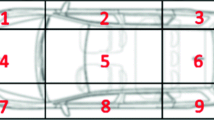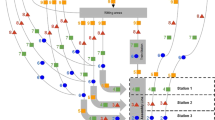Abstract
Asynchronous assembly lines are productive layouts in which products move sequentially between stations when processing at current station is complete, and the following station is empty. When these conditions are not verified, downstream starvations and upstream blockages can occur. Buffers are often employed to minimize these problems, which are particularly relevant when the line is shared between a set of different products models (mixed-model lines). If the sequence of such models is cyclical, a steady-state production rate is eventually reached. However, determining (and, therefore, optimizing) such steady-state is challenging. This led to the development of indirect performance measures for mixed-model lines by many authors. In this paper, a direct performance measure is presented with a mixed-integer linear programming model and compared to previous formulations. The model is also applied to a practical case study and to a new dataset (with 1050 instances), allowing general assertions on the problem. All instances are solved with a universal solver and solutions are validated with a simulation software. Tests on the dataset instances confirmed the observations made on the case study: the proposed formulation produced solutions with higher production rate in 82% of the instances and tied the remaining ones, not being outperformed a single time. A triple interdependency of task balancing, product sequencing, and buffer allocation is demonstrated. Cyclical schedules show how buffers are able to compensate differences between models across stations and lead to the conclusion that the propagation of differences of models between stations can generate scheduling bottlenecks (blockages and starvation).

Source: Lopes et al. (2016). (Color figure online)






Source: Lopes et al. (2016)


Similar content being viewed by others
Notes
The value 250 time units is employed based on the optimal processing time from answers obtained by other formulations.
The value 160 time units is employed based on observed cycle time values of other formulations.
Horizontal balancing HX is not tested due to its poor performance on the practical case study and to its non-linearities that prevent optimal solutions from being found.
In an MPS of five units (1, 1, 1, 1, 1), by fixating the first model in the first position, one can generate 4! combinations of cyclical sequences. Each sequence requires a quick simulation of a few replications of the MPS going through the line. Alternatively, linear relaxations of the proposed model can be used.
References
Alexander, D. R., Premachandra, I. M., & Kimura, T. (2010). Transient and asymptotic behavior of synchronization processes in assembly-like queues. Annals of Operations Research, 181, 641–659. https://doi.org/10.1007/s10479-010-0796-9.
Bard, J. F., Dar-elj, E., & Shtub, A. (1992). An analytic framework for sequencing mixed model assembly lines. International Journal of Production Research, 30(1), 35–48. https://doi.org/10.1080/00207549208942876.
Battaïa, O., & Dolgui, A. (2013). A taxonomy of line balancing problems and their solution approaches. International Journal of Production Economics, 142, 259–277. https://doi.org/10.1016/j.ijpe.2012.10.020.
Battini, D., Faccio, M., Persona, A., & Sgarbossa, F. (2009). Balancing–sequencing procedure for a mixed model assembly system in case of finite buffer capacity. International Journal of Advanced Manufacturing Technology, 44, 345–359. https://doi.org/10.1007/s00170-008-1823-8.
Becker, C., & Scholl, A. (2006). A survey on problems and methods in generalized assembly line balancing. European Journal of Operational Research, 168, 694–715. https://doi.org/10.1016/j.ejor.2004.07.023.
Boysen, N., Fliedner, M., & Scholl, A. (2008). Assembly line balancing: Which model to use when? Intern Journal of Production Economics, 111, 509–528. https://doi.org/10.1016/j.ijpe.2007.02.026.
Boysen, N., Fliedner, M., & Scholl, A. (2009a). Production planning of mixed-model assembly lines: Overview and extensions. Production Planning & Control: The Management of Operations, 20(5), 455–471. https://doi.org/10.1080/09537280903011626.
Boysen, N., Fliedner, M., & Scholl, A. (2009b). Sequencing mixed-model assembly lines: Survey, classification and model critique. European Journal of Operational Research, 192, 349–373. https://doi.org/10.1016/j.ejor.2007.09.013.
Bukchin, J. (1998). A comparative study of performance measures for throughput of a mixed model assembly line in a JIT environment. International Journal of Production Research, 36(10), 2669–2685.
Dar-El, E. M., Herer, Y. T., & Masin, M. (1999). CONWIP-based production lines with multiple bottlenecks: Performance and design implications. IIE Transactions, 31, 99–111.
Demir, L., Tunali, S., & Eliiyi, D. T. (2014). The state of the art on buffer allocation problem: A comprehensive survey. Journal of Intelligent Manufacturing, 25(3), 371–392. https://doi.org/10.1007/s10845-012-0687-9.
Golle, U., Rothlauf, F., & Boysen, N. (2015). Iterative beam search for car sequencing. Annals of Operations Research, 226, 239–254. https://doi.org/10.1007/s10479-014-1733-0.
Gurevsky, E., Battaïa, O., & Dolgui, A. (2012). Balancing of simple assembly lines under variations of task processing times. Annals of Operations Research, 201, 265–286. https://doi.org/10.1007/s10479-012-1203-5.
Gurgur, C. Z. (2013). Optimal configuration of a decentralized, market-driven production/inventory system. Annals of Operations Research, 209, 139–157. https://doi.org/10.1007/s10479-011-0977-1.
Heath, S. K., Bard, J. F., & Morrice, D. J. (2013). A GRASP for simultaneously assigning and sequencing product families on flexible assembly lines. Annals of Operations Research, 203, 295–323. https://doi.org/10.1007/s10479-012-1167-5.
Karabati, S., & Kouvelis, P. (1994). The interface of buffer design and cyclic scheduling decisions in deterministic flow lines. Annals of Operations Research, 50, 295–317.
Kellegöz, T. (2016). Assembly line balancing problems with multi-manned stations: A new mathematical formulation and Gantt based heuristic method. Annals of Operations Research, 253(1), 377–404. https://doi.org/10.1007/s10479-016-2156-x.
Koenigsberg, E. (1959). Production lines and internal storage—A review. Management Science, 5(4), 410–433. https://doi.org/10.1287/mnsc.5.4.410.
Leu, Y., Huang, P. Y., & Russell, R. S. (1997). Using beam search techniques for sequencing mixed-model assembly lines. Annals of Operations Research, 70, 379–397. https://doi.org/10.1023/A:10189386.
Levner, E., Kats, V., Alcaide, D., Pablo, L. D., & Cheng, T. C. E. (2010). Complexity of cyclic scheduling problems: A state-of-the-art survey. Computers & Industrial Engineering, 59(2), 352–361. https://doi.org/10.1016/j.cie.2010.03.013.
Lopes, T. C., Sikora, C. G. S., & Magatão, L. (2016). Buffer and cyclical product sequence aware assembly line balancing problem: Model and steady-state balancing case study. In Annals of the XLVIII SBPO, Vitória-ES, Brazil (pp. 3458–3469).
Lopes, T. C., Sikora, C. G. S., Molina, R. G., Schibelbain, D., Rodrigues, L Cd A, & Magatão, L. (2017). Balancing a robotic spot welding manufacturing line: An industrial case study. European Journal of Operational Research, 263(3), 1033–1048. https://doi.org/10.1016/j.ejor.2017.06.001.
Matanachai, S., & Yano, C. A. (2001). Balancing mixed-model assembly lines to reduce work overload. IIE Transactions, 33, 29–42. https://doi.org/10.1080/07408170108936804.
Merengo, C., Nava, F., & Pozzetti, A. (1999). Balancing and sequencing manual mixed-model assembly lines. International Journal of Production Research, 37(12), 2835–2860. https://doi.org/10.1080/002075499190545.
Otto, A., Otto, C., & Scholl, A. (2013). Systematic data generation and test design for solution algorithms on the example of SALBPGen for assembly line balancing. European Journal of Operational Research, 228(1), 33–45. https://doi.org/10.1016/j.ejor.2012.12.029.
Özcan, U., Çerçioglu, H., Gökçen, H., & Toklu, B. (2010). Balancing and sequencing of parallel mixed-model assembly lines. International Journal of Production Research, 48(17), 5089–5113. https://doi.org/10.1080/00207540903055735.
Öztürk, C., Tunali, S., Hnich, B., & Örnek, A. (2015). Cyclic scheduling of flexible mixed model assembly lines with parallel stations. Journal of Manufacturing Systems, 36, 147–158. https://doi.org/10.1016/j.jmsy.2015.05.004.
Öztürk, C., Tunali, S., Hnich, B., & Örnek, M. A. (2013). Cyclic scheduling of flexible mixed model assembly lines. IFAC,. https://doi.org/10.3182/20130619-3-RU-3018.00413.
Pastor, R., Andrés, C., Duran, A., & Péres, M. (2002). Tabu search algorithms for an industrial multi-product and multi-objective assembly line balancing problem, with reduction of the task dispersion. The Journal of Operational Research Society, 53(12), 1317–1323. https://doi.org/10.1057/palgrave.jors.2601457.
Salveson, M. E. (1955). The assembly line balancing problem. The Journal of Industrial Engineering, 6, 18–25.
Sawik, T. (2000). Simultaneous versus sequential loading and scheduling of flexible assembly systems. International Journal of Production Research, 34(14), 3267–3282. https://doi.org/10.1080/002075400418252.
Sawik, T. (2004). Loading and scheduling of a flexible assembly system by mixed integer programming. European Journal of Operational Research, 154, 1–19. https://doi.org/10.1016/S0377-2217(02)00795-6.
Sawik, T. (2012). Batch versus cyclic scheduling of flexible flow shops by mixed-integer programming. International Journal of Production Research, 50(18), 5017–5034. https://doi.org/10.1080/00207543.2011.627388.
Scholl, A. (1999). Balancing and sequencing assembly lines (2nd ed.). Heidelberg: Physica.
Scholl, A., & Becker, C. (2006). State-of-the-art exact and heuristic solution procedures for simple assembly line balancing. European Journal of Operational Research, 168, 666–693. https://doi.org/10.1016/j.ejor.2004.07.022.
Scholl, A., Boysen, N., & Fliedner, M. (2009). Optimally solving the alternative subgraphs assembly line balancing problem. Annals of Operations Research, 172, 243–258. https://doi.org/10.1007/s10479-009-0578-4.
Sikora, C. G. S., Lopes, T. C., & Magatão, L. (2017). Traveling worker assembly line (re)balancing problem: Model, reduction techniques, and real case studies. European Journal of Operational Research, 259(3), 949–971. https://doi.org/10.1016/j.ejor.2016.11.027.
Spinellis, D. D., & Papadopoulos, C. T. (2000). A simulated annealing approach for buffer allocation in reliable production lines. Annals of Operations Research, 93, 373–384.
Thomopoulos, N. T. (1970). Mixed model line balancing with smoothed station assignments. Management Science, 16(9), 593–603.
Tiacci, L. (2015). Simultaneous balancing and buffer allocation decisions for the design of mixed-model assembly lines with parallel workstations and stochastic task times. International Journal of Production Economics, 162, 201–215. https://doi.org/10.1016/j.ijpe.2015.01.022.
Acknowledgements
The authors would like to thank the financial support from Fundação Araucária—Agreements 141/2015, 06/2016 and 041/2017 FA-UTFPR-RENAULT, and CNPq (Grant 406507/2016-3).
Author information
Authors and Affiliations
Corresponding author
Electronic supplementary material
Below is the link to the electronic supplementary material.
Rights and permissions
About this article
Cite this article
Lopes, T.C., Sikora, C.G.S., Michels, A.S. et al. Mixed-model assembly lines balancing with given buffers and product sequence: model, formulation comparisons, and case study. Ann Oper Res 286, 475–500 (2020). https://doi.org/10.1007/s10479-017-2711-0
Published:
Issue Date:
DOI: https://doi.org/10.1007/s10479-017-2711-0




